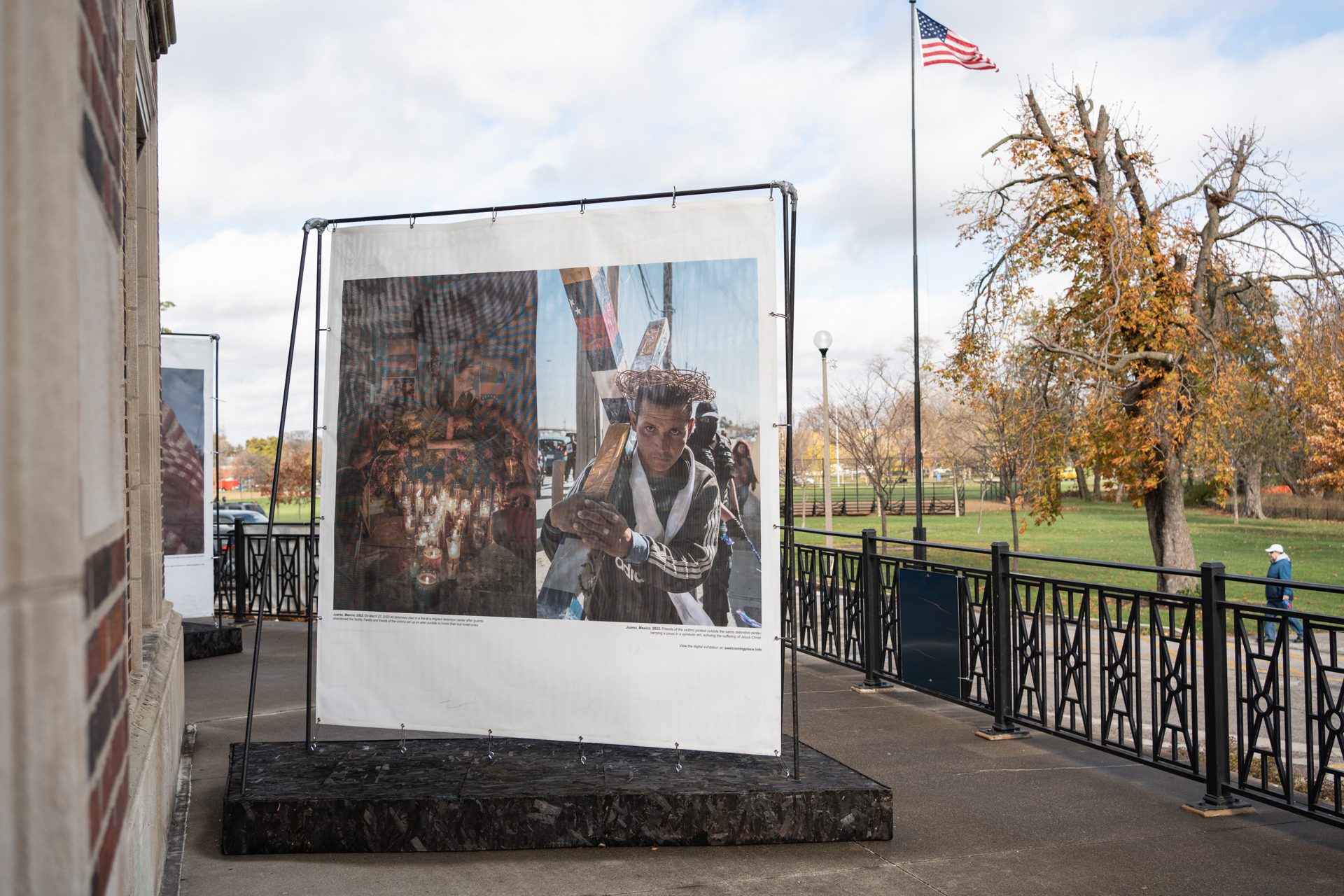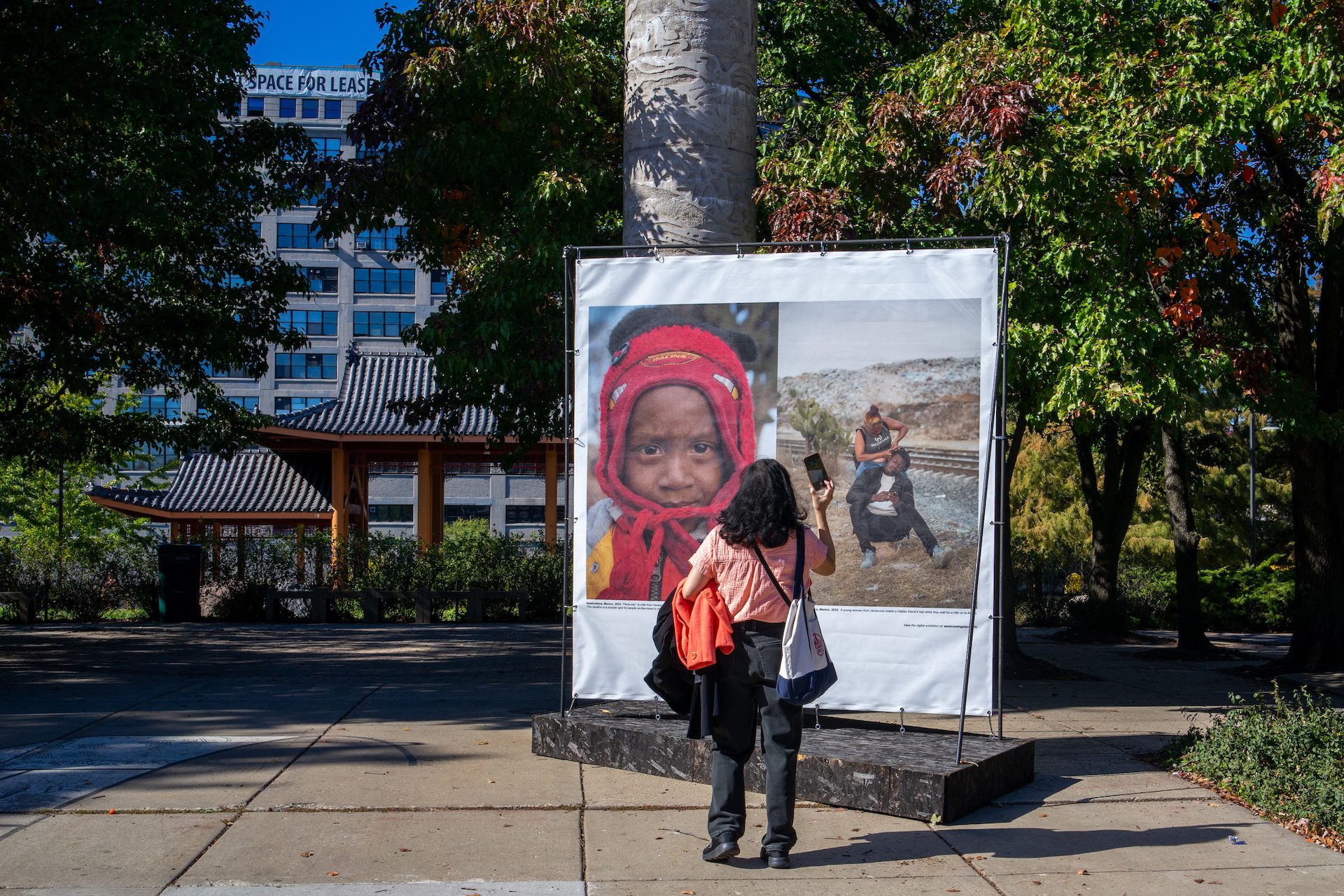 Max Herman/Borderless Magazine
Max Herman/Borderless MagazineAfter two years of traveling alongside asylum seekers, two photographers share their work to expand conversations on immigration.
Next to the Humboldt Park Field House entrance, four photo pairings standing 8 feet by 7 feet capture moments along different migrant trails.
In one diptych, a photograph displays a vigil for victims of a fire at a migrant detention center in Ciudad Juárez, Mexico. The accompanying photo is a close-up of a man looking ahead, carrying a cross at a protest outside the same detention facility.
These photographs are part of an outdoor installation at the Chicago Park District entitled “A Welcoming Place.” Produced by ART WORKS Projects, the exhibit offers a glimpse of the migrant experience through a lens of compassion and empathetic photographs from Wil Sands and Oscar B. Castillo.
News that puts power under the spotlight and communities at the center.
Sign up for our free newsletter and get updates twice a week.
Sands and Castillo’s photographs are currently on display at two Chicago parks in Chinatown’s Ping Tom Park and Humboldt Park. A third exhibition site recently closed at Marquette Park.
The exhibition is part of a larger project, “Borders Cruzadas.” The project is the culmination of two years of documenting the complexities of immigration during a time when many have sought asylum in the U.S. Sands and Castillo’s photographs focus on the stories of people migrating north, with portraits and scenes from the Guatemala-Mexico border, Juárez, and sanctuary cities like New York.
“The journey is different for everyone,” said Castillo, who is originally from Venezuela. “So if you are accompanying somebody long enough, you will start to see not only the particularities of their journey but the particularities of the person — the human experience.”
Read More of Our Coverage
These two photographers traveled alongside people to help break the rigidity of the conversations regarding immigration.
Sands notes that reductionist narratives often put migrants in the framing of either victims or criminals. “That only happens because we have these reductionist conversations,” he said. “And the only way I feel like we can add complexity back to the conversation is really centering the human experience with people that are living it and trying to center that voice in the conversation and in the way that we depict what’s happening as it relates to immigration.”
While the photographers document some of the harsh realities migrants face along the way, they also capture quiet, communal moments, like a young woman from Venezuela braiding the hair of a Haitian friend as they wait for a ride on the notoriously dangerous train, “La Bestia.”
“There’s a lot of hardship to this history, and there’s a lot of difficult situations,” Castillo said. “We are not blind to that. But what we don’t see much is success. People building community, integrating, exchanging with some other parts of their community — being a cultural community.”

Community engagement is essential to their “Border Cruzadas” project. Over the last six months, they’ve held exhibits at spaces like the Chicago Parks District and Pueblo Unido Gallery at Centro Romero, hosted workshops, and community conversations. ART WORKS Projects, which commissioned “A Welcoming Place” installation, created a curriculum for youth art classes, and later partnered with the Chicago Park District last summer.
Sands and Castillo feel they can widen the conversation by bringing all aspects of the project into specific neighborhoods with a history of immigrants where new arrivals are finding a new home.
“If we think about policy reform or policy impact right now, as it relates to migration, at a federal level, it seems like there’s a total standstill,” Sands said. “There’s no space to move on. On the flip side, on a local level, it feels like there’s a lot of space, and actually there’s opportunity there, to actually have some impact.”
Correction 11/21/24: This story has been updated to clarify ART WORKS Projects’ role in producing “A Welcoming Place” and the creation of the youth art curriculum hosted at Chicago Parks District last summer.
Exhibits part of A Welcoming Place in Chicago parks will be on display until Nov. 22 at Humboldt Park, near the field house, and at Ping Tom Park, past the train tracks at the 19th Street entrance. For more information, visit https://www.awelcomingplace.info/
Max Herman is a visuals editor at Borderless Magazine. Max can be reached at [email protected].

